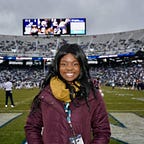NCAA has failed black male athletes
While the NCAA prides itself on “[integrating] intercollegiate athletics into higher education,” one of its largest failures as a governing body is its lackluster attempt to fix the educational inequalities that exist in male revenue generating sports.
According to research conducted by Dr. Shaun Harper at the University of Southern California’s Race and Equity Center, black men are overrepresented on Power Five football and basketball teams, yet continue to graduate at some of the lowest rates of all groups at their respective institutions.
Harper’s data, updated in 2018 though also conducted in 2012 and 2016, point to an age-old problem with the NCAA — exploiting athletes, particularly black males.
Looking at the Big Ten, black athletes make up less than 3 percent of the student population at all of the member institutions but average out to almost half of each school’s football and basketball programs.
With the exception of Northwestern, the conference’s premier private institution, black athletes graduate at rates at least 10 percent less than athletes overall and on average, 24 percent below the institution’s overall graduation rate.
While there are many contributing factors that hinder graduation rates for black male athletes in Power Five conferences, including already pervasive inequities in K-12 education, the failure to truly prioritize education plays a substantial role.
As it stands, collegiate athletics is an industry that gives athletic programs and coaches almost no incentive to fix educational inequities.
According to Harper’s data, football coaches in Power Five conferences earn on average $3.7 million in yearly salaries and basketball coaches earn on average $2.7 million. In addition, athletic directors take home annual salaries that average $707,418.
Though college coaches receive bonuses for graduating players, for instance, Alabama head coach Nick Saban’s $100,000 graduation success bonus in 2015, the real money is in the wins on the field.
Following James Franklin’s 2016–2017 season that saw the Nittany Lions clinch the Big Ten Championship and a berth at the Rose Bowl, Franklin took home almost $750,000 in bonuses for leading the blue and white to one of its most successful seasons in years.
On the conference level, the Big Ten took in more than $100 million that same season on the success of its member institutions. These numbers are even higher when adding television rights and merchandise sales.
To Dr. Boyce Watkins, a former professor who has taught at multiple schools with major athletic programs, when looking at incentives coaches and departments receive, the cycle of low-performing athletes is no surprise.
“If you are a coach and you’ve got a $5 million a year job on the line and your university has clearly stated in the contract that winning games is your number one priority; how much time are you really going to put into making sure these young men get educated? None,” he said in an interview with the Final Call.
While the NCAA continues to receive backlash on its academic success rate for black athletes, Mark Emmert, the governing body’s president is adamant that the situation is improving.
“The dramatic improvement in the graduation rate for African-American student-athletes in all sports is a significant achievement, and our student-athletes and member schools should be proud of the work they are doing,” he said in a release from the association in November. “The goal of all the NCAA’s academic policies and programs is to prepare students for life after college, and graduation is integral to this success.”
Yet, until the NCAA makes its number one priority to educate athletes, rather than to make money, the educational gaps will continue to exist.
As Harper said in 2006, “perhaps nowhere in higher education is the disenfranchisement of black male students more insidious than in College Athletics.”
